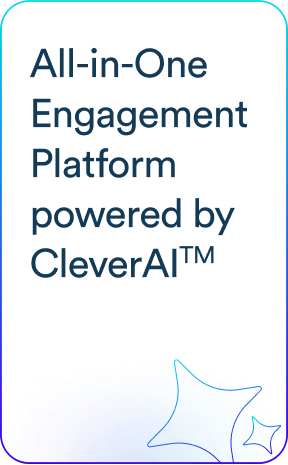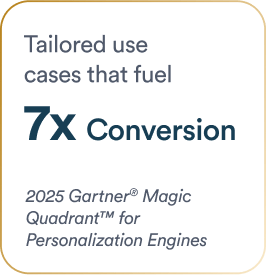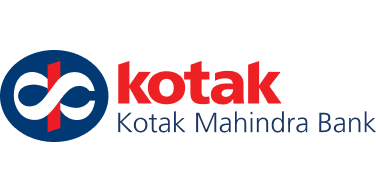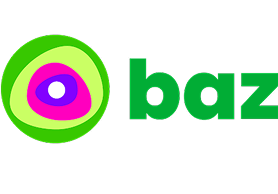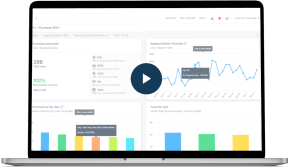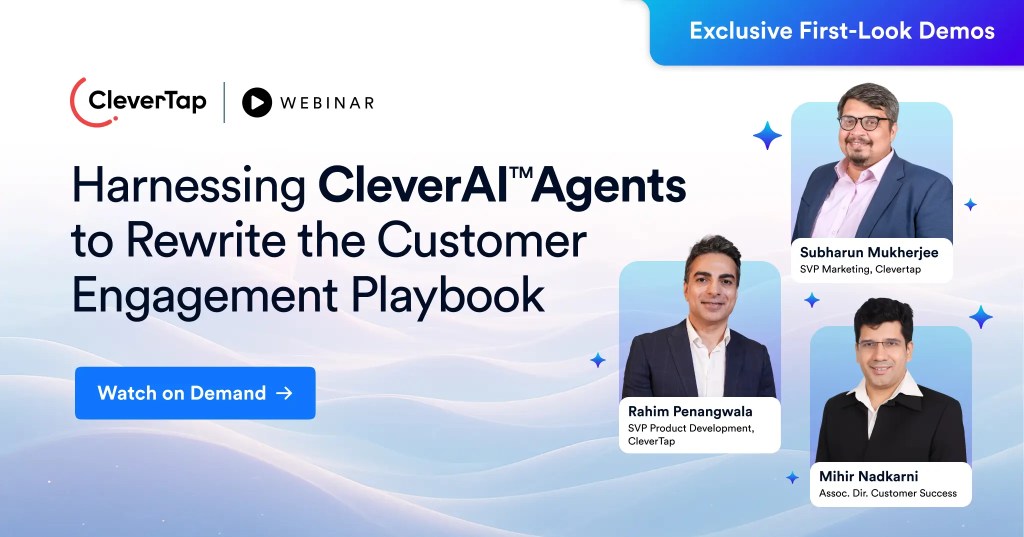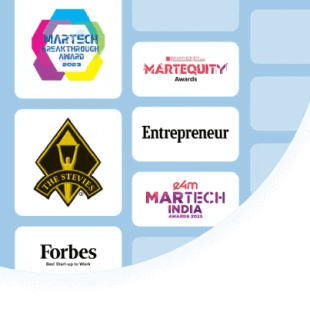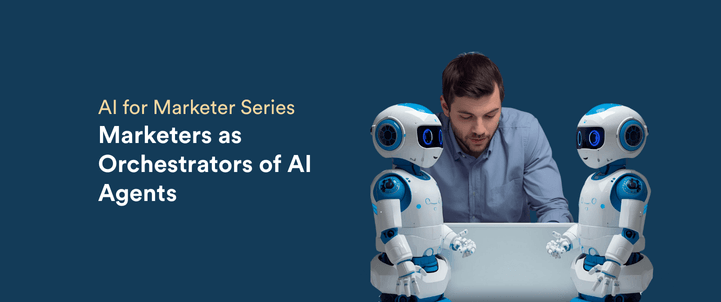Marketing has always been about storytelling – and marketers plan and execute carefully crafted strategies to bring their stories to life. But these stories are no longer written by marketers alone.
AI systems have been assisting marketers in performing various tasks efficiently for years. However, until now, AI in marketing was about tools – automating repetitive tasks, generating insights, or providing personalized recommendations. With the rise of AI agents, we’re entering a new era where machines aren’t just tools; they’re collaborators.
A recent study found the top applications of AI in marketing include data analysis (45%), market research (40%), copywriting (27%), image generation (22%), and customer service (13%).
But there’s a catch: AI can act autonomously, but it can’t think strategically – at least not yet.
That’s where marketers step in as the orchestrator – leading, supervising, and harmonizing AI-driven experiences to ensure they’re on-brand, ethical, and effective.
This blog unpacks the role of marketers as orchestrators in today’s AI-first world, skills required to step into this role efficiently, the AI orchestration framework, and more.
Why Marketers Must Become Orchestrators
Imagine an e-commerce brand. An AI tool can recommend products based on purchase history. But an AI agent? It can predict the likelihood of purchase, trigger a relevant offer, craft a contextual message, and send it on the most appropriate channel at the best time – all without waiting for the marketer’s input.
And yet, even the smartest agents need direction. Which brings us to the marketer’s evolving role. This includes:
1. Setting the Strategy
AI agents excel at execution, but strategy comes from humans. Marketers define business objectives and campaign goals, target personas and messaging frameworks, and guardrails for tone, compliance, and brand identity. Agents operate and perform within these frameworks.
2. Supervising Autonomous Systems
Unsupervised AI can amplify risks, such as off-brand messaging, biased targeting, misleading recommendations, or even inappropriate behaviour. Marketers act as the conscience of AI – reviewing, correcting, and refining outputs. The level of autonomy depends on the level of trust placed in the AI system.
3. Integrating the Human Touch
While AI optimizes for efficiency, humans optimize for empathy. Marketers balance performance-driven personalization with customer-centric storytelling.
The AI-Orchestrator Skillset
The most successful marketing teams will be those that treat AI as team members, not tools. To thrive in this new paradigm, marketing leaders need a hybrid skillset – part strategist, part technologist, part ethicist.
- Strategic Oversight: This involves defining brand-aligned rules and objectives for AI agents and turning business strategy into executable AI playbooks.
- Data Literacy & Interpretation: Marketers should be able to comprehend and validate AI-driven insights as well as identify anomalies and biases in predictions or personalization.
- Ethical & Responsible AI Supervision: Complying with applicable data privacy and security regulations and frameworks is essential for building trust in the AI agents. Marketers should ensure that the agentic systems operate within the regulatory perimeter and maintain transparency in how data is used.
- Cross-Functional Collaboration: The marketer should liaise with data scientists to set model parameters, product and engineering to integrate AI outputs, compliance and legal teams to manage risk, and so on.
The Marketer-AI Orchestration Framework
To make orchestration actionable, marketers need a structured model that balances autonomy with oversight, ensuring AI drives outcomes while staying aligned with the bigger picture. Here’s a five-step orchestration framework designed for modern marketers:
Step 1: Define Objectives (Set the North Star)
Before activating AI agents, marketers must start with clarity of purpose. This requires:
- Establishing business goals, such as customer acquisition, retention, upselling, engagement, or lifetime value.
- Mapping objectives to customer lifecycle stages to ensure contextual orchestration.
- Prioritizing key performance indicators (KPIs) so AI agents work toward measurable outcomes.
Instead of feeding AI a list of tasks, marketers should define the “why” behind each objective. AI performs best when it knows what success looks like.
Step 2: Configure AI Agents (Set Guardrails and Intent)
By setting clear parameters upfront, marketers ensure AI agents act proactively but predictably. This encompasses:
- Audience Segmentation Rules: Define how customers are grouped based on behavior, intent, and value.
- Brand Voice & Tone: Train AI to maintain consistency across messaging and touchpoints.
- Compliance & Ethical Guidelines: Embed privacy rules, consent frameworks, and responsible personalization parameters.
- Performance Thresholds: Define success benchmarks and stop-loss triggers to prevent over-optimization.
Step 3: Monitor & Optimize (Stay in the Conductor’s Seat)
While AI agents autonomously optimize campaigns, marketers must actively monitor outputs and feedback loops. Think of it like conducting a symphony – the instruments (AI agents) may know their parts, but the conductor ensures harmony. Marketers should:
- Use real-time dashboards to track campaign health, conversion rates, and customer sentiment.
- Spot anomalies early – from sudden drops in engagement to unexpected behavior in personalized offers.
- Refine prompts, rules, and datasets based on observed performance.
Step 4: Escalate Exceptions (Human-in-the-Loop Interventions)
Not every customer interaction should be automated. Marketers need to closely monitor AI outputs, especially scenarios requiring empathy, creativity, or judgment. According to a recent study, agentic AI systems are expected to handle 68% of all customer service and support interactions by 2028 – putting a huge onus on brands and marketers to ensure AI agents operate as intended.
To maintain customer trust while preserving operational efficiency, it is essential to define clear escalation paths so AI agents know when to hand off to humans:
- Sensitive Conversations: Complaints, escalations, or emotionally charged moments.
- Complex Decisions: High-value upsells, retention negotiations, or B2B contract renewals.
- Ethical Dilemmas: When AI recommendations conflict with company values or compliance frameworks.
Step 5: Continuously Learn & Adapt (Close the Loop)
The most successful AI-orchestrated systems are living ecosystems – constantly evolving with new insights, data, and behaviors.
- Feed customer engagement data back into AI models to improve personalization accuracy.
- Iterate on segmentation rules and campaign triggers based on real-world results.
- Use cross-channel insights to fine-tune orchestration across the customer lifecycle.
This step transforms AI from a reactive executor into a self-improving collaborator — one that learns from marketers as much as marketers learn from it.
Orchestrate, Don’t Automate
AI agents are changing the game, but they can’t replace human judgment. Marketers are being enabled to step into more strategic roles, orchestrating a symphony of AI-driven experiences while protecting brand trust and customer relationships.
For this orchestration to succeed, trust is the foundation – and that trust in AI systems is built gradually. At CleverTap, we call this journey the AI Trust Ladder: from Stage 0 (manual control) to Stage 3 (full autonomous execution), where marketers evolve from solo performers to true orchestrators-in-chief.
The future belongs to marketers who lead AI, not follow it. AI can execute, but only marketers can orchestrate. The brands that win tomorrow will be those where humans and AI work in concert, delivering intelligent engagement without losing the human touch.
Subharun Mukherjee 
Heads Cross-Functional Marketing.Expert in SaaS Product Marketing, CX & GTM strategies.
Free Customer Engagement Guides
Join our newsletter for actionable tips and proven strategies to grow your business and engage your customers.

